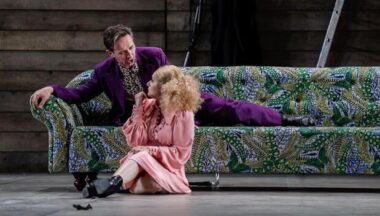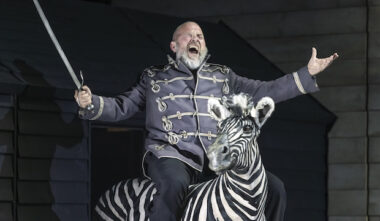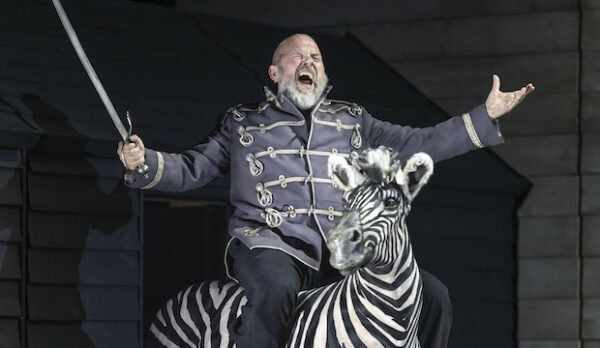 United Kingdom Garsington Opera 2023 [2] – Mozart, Mitridate, re di Ponto: Soloists, The English Concert / Clemens Schuldt (conductor). Garsington Opera at Wormsley, 3.6.2023. (CR)
United Kingdom Garsington Opera 2023 [2] – Mozart, Mitridate, re di Ponto: Soloists, The English Concert / Clemens Schuldt (conductor). Garsington Opera at Wormsley, 3.6.2023. (CR)

Production:
Director – Tim Albery
Designer – Hannah Clark
Lighting Designer – Malcom Rippeth
Cast:
Mitridate – Robert Murray
Aspasia – Elizabeth Watts
Sifare – Louise Kemény
Farnace – Iestyn Davies
Ismene – Soraya Mafi
Arbate – John Graham-Hall
Marzio – Joshua Owen Mills
It is a bold decision to mount the 14-year-old Mozart’s fifth stage work, Mitridate: although it is at least as musically accomplished as any comparable work by his contemporaries (and many of its arias are memorable) it still requires an audience to be sympathetic with the particular structure, complex plot devices, and themes of eighteenth-century opera seria. It is as much the name of Mozart – the composer of at least seven immortal operas later in his career – that keeps this work in the repertoire at all today where so many similar operas from the seventeenth and eighteenth centuries are almost never encountered (Alessandro Scarlatti’s Mitridate Eupatore, about the same monarch, anybody?!). It is also courageous of Tim Albery to present the work in a pared down setting which ignores its essentially extravagant Baroque conventions and avoids the colour and choreographic exuberance of Graham Vick’s kabuki-inspired production which has been seen at the Royal Opera House on several occasions over the last thirty years. The opera was based on the play of 1673 by Jean Racine, which concerns the King of Pontus, Mithridates VI’s war with the Romans, as well as his own domestic tussles in that both his sons, Farnace and Sifare love his fiancée, Aspasia (though she only returns Sifare’s love).
This production concentrates the drama within an embattled and rather bare chamber in which those military and personal struggles claustrophobically play out. On the one hand it serves like a bunker from which Mitridate and his adviser Arbate keep watch through its small lookout window against advancing enemies (the black sheds at the sides seem to be explicable only as mimicking those elsewhere on the Wormsley estate, providing no bearing on the work itself). On the other it is like a nursery in which the spoilt, unruly Farnace indulges his fantasies in taking over the throne and siding with the Romans (he sports a suitably imperial purple silk dressing gown, and suit subsequently) as he plays with the figurines of a toy army.

A Freudian interpretation of the dynamics of patriarchal authority is perhaps just hinted at in that infantilisation of Farnace especially, but also of Sifare, when they are sat down in front of a map of the Empire and Mitridate explains his megalomaniac military intentions, as though in a schoolroom; and also by having Farnace melodramatically stab the Roman officer Marzio (not in the original scenario) as though overthrowing one spectre of authority once he decides to return to his father’s cause. A barely less infantile obsession with empire-building – on the part of either Mitridate or his sons – also seems to be alluded to by such symbols of imperial derring-do as the stuffed zebra, globe, cabinet with weapons, and Mitridate’s luggage trunk (all redolent of the Edwardian heyday of the British Empire) although seeing that it is the Romans who have actually attained an empire, and not Mitridate, it seems somewhat odd to give such spoils to the latter. Such ideas as there are tend to be specious or underexplored, therefore, so the impression is more a series of dramatically meretricious stunts rather than sustaining any overarching interpretation or concept, which is rather confirmed by the final bloodied appearance of Mitridate after his fatal showdown with the Romans, which aims at the shock value of a TV crime thriller, not psychological acuity.
By cutting swathes of recitative probably too drastically (though so did Jean-Pierre Ponnelle for his film), as well as a few of the arias and some da capos, if that makes for a snappier drama, it frustrates any more detailed development of character and so its sequence of arias also comes to seem somewhat episodic rather than constituting a more richly structured and varied music drama. (One of the omitted arias is the single, graceful one for Arbate, which means that John Graham-Hall only contributes to the recitatives, and incidentally that role is transposed down for tenor, since it was originally written for a castrato.) Although the performance retains the March (K62, nearly contemporaneous with the opera, though actually written as the opening of the Serenade K100) usually interpolated to announce Mitridate’s first appearance, here it is shifted to a later point, to open the second part. Its strutting pomp then hardly makes the connection with Mitridate’s hubristic ambitions in taking on the Roman Empire, and becomes rather redundant in prefacing, instead, an aria by Ismene (the intended bride for Farnace).
The cast undoubtedly bring more consistent personality and character in the musical performance. Robert Murray gives an often lyrically expressive account of the title part, suggesting a noble humanity in his sonorous arias ‘Se di lauri’ on his return home and ‘Tu, che fedel’ addressed to Sifare before he understands his and Aspasia’s love; but he also encompasses striking agitation and contrast in the impassioned scena which closes Act I. Farnace’s wiliness is aptly caught by Iestyn Davies’s ripe but controlled tone in arias which prefer more sustained lines over the more obvious sort of coloratura which might have conveyed that trait. Some lustrous singing from Louise Kemény belies a fairly passive, inscrutable interpretation of the more forbearing Sifare on stage, but her steady, brightly delivered musical lines embody the calm sincerity of Mitridate’s younger son, above all in the sublime aria with horn solo ‘Lungi da te, mio bene’, and it is only in the more excitable ‘Se il rigor d’ingrata sorte’ towards the end of Act III that she becomes a touch squally (the omission of ‘Parto: nel gran cimento’ denies her the chance to tackle its vivid coloratura).
Elizabeth Watts frequently soars with a sweet-voiced charm as Aspasia, bringing the sort of intensity and variety to her anguished ‘Nel grave tormento’ (ending the first part of this performance) that looks ahead to the roles of the Countess Almaviva or Fiordiligi, rounded off by a captivating cadenza with the solo horn. By contrast Soraya Mafi is a flighty Ismene with a steely edge to her florid music, while Joshua Owen Mills delivers Marzio’s single aria solidly.
Clemens Schuldt ensures a generally vigorous rendition of the score with The English Concert, though it a touch too hasty in some arias perhaps (such as Farnace’s ‘Venga pur’) and so skates over some detail. But on the whole they keep up ample pace and tension, and the ensemble’s extensive experience in Handel’s similarly structured operas pays off as the arias exert themselves as a brilliant flash of energy at the end of each scene before the performers proceed quickly to the next, which happily forestalls disruptive applause after each number, and offers more colour and energy than the production.
Curtis Rogers
